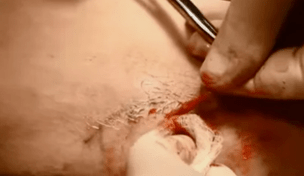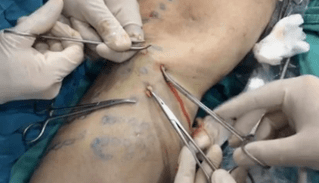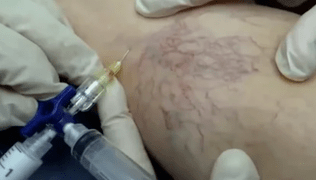Varicose veins or varicose veins, the formulation in this phlebology means pathology accompanied by modification, i. e. vein deformation. The blood vessels that transport blood to the heart dilate, lengthen, thin the walls, and even interfere with the work of venous valves.
If first-degree varicose veins are effectively treated with conservative methods, then the progression of the disease to stages 2 and 3 can only be cured with surgery, medications and other methods can only stop the development of pathology. This article will discuss the main surgical methods to treat varicose veins, the peculiarities of their implementation, and so on.
Instructions for surgical intervention

Given the fact that in the early stages of varicose vein development, surgical intervention is very rare due to lack of necessity, a very important factor is the indication for surgery. Decisions are based on data obtained during a detailed diagnosis of blood vessels, and are made by the patient together with the physician.
A phlebologist is obliged to inform about the risks of the proposed operation, the duration and nuances of recovery after surgery, which are then performed only with the patient's consent.
Regarding the indication itself, surgery for varicose veins is required in cases such as:
- Pathological dilatation and subsequent deformation of the pure saphenous vein of the second degree of severity and above.
- Extensive forms of varicose veins, the disease not only affects the saphenous veins, but also the deep veins, or the deformation of the vessels extends to the lower extremities too much.
- There is a serious circulatory disorder accompanied by deteriorating stagnant blood processes.
- Severe form of swelling, high-intensity pain syndrome, accompanied by signs of different external (aesthetic) varicose veins.
- Formation of trophic ulcers on the skin or subcutaneous hematoma due to vascular integrity disorders;
- Progress of pathological processes to venous blockage and development of acute thrombophlebitis.
- Lack of positive dynamics during conservative treatment, i. e. when medications and other methods to deal with varicose veins are helpless.
Limitations and contraindications for surgery
Unfortunately, even with the development of severe forms of varicose veins, accompanied by complications and severe clinical picture, patients may not always undergo surgery.
There are a number of contraindications, which, if not excluding the possibility of surgical intervention, will have to suspend surgery for a certain period of time:
- Ischemic heart disease - in this case, a more comprehensive examination should be performed.
- The same is true for class 3 hypertension.
- The process of infection and inflammation that is active in the body - before performing surgery to treat varicose veins, you need to overcome the infection or get rid of the inflammation.
- 2nd and 3rd trimester of pregnancy - for pregnant women, it is better to postpone any surgical procedure until the woman gives birth. The only exceptions are cases when there is a serious danger to the life of the mother or child, and surgery can help.
- Skin disease in the operating area to combat varicose veins. We talked about eczema, various forms of dermatosis, and so on.
- There are also certain age limits, of course, for the elderly. In some cases, old age, as well as concomitant old age diseases, increase the risk of postoperative complications or endanger a person's life at the operating table.
Surgical intervention methods for varicose veins
If, however, the doctor, based on diagnostics and after examining the patient, is convinced of the need for surgical intervention, still needs to choose the most appropriate and effective method, depending on the stage of development of varicose veins and a number of other factors. To understand what surgery is and in what case it is performed, we will consider the most effective method of varicose vein surgical treatment.
Combined phlebectomy

Full operation performed under general anesthesia and can last up to 2 hours, depending on the complexity of the task. Phlebectomy can be used to treat early forms of varicose veins, but more often this method is used in further cases when the disease has developed seriously.
During surgery, surgeons make incisions 2 centimeters long for the ankle, or up to 5 centimeters for a wider area such as the groin. Often, these incisions are superficial, as the superficial veins are mainly removed.
The principle of surgery is to bind the vessel anastomosis by removing the part of the vein that is affected by the varicose veins. Also, during surgery, the surgeon can correct the venous valve to restore normal blood flow.
After surgery, cosmetic sutures are applied to the incision, a bandage is made and an elastic bandage is applied to the treated area to prevent bleeding.
Miniflebectomy
During this procedure, the affected vein area is also cut, but the scale of the operation is smaller, it can be considered cosmetic only. The point is that the doctor makes a small puncture in the skin, where he removes the part of the vein that needs to be cut. The operation is performed primarily on small vessels, and its advantages are painless (due to local anesthesia) and minimal recovery period.
Sclerotherapy
A relatively young technique, a minimally invasive method, known for its effectiveness, as well as the absence of painful sensations due to the same local anesthesia and almost no recovery period.

This procedure involves the introduction of a special substance into the lumen of the vein - a foaming sclerosant. This material leads to the collapse of the vessel wall with subsequent adhesion. As a result, the veins stop participating in the circulatory process, gradually dissolving and being replaced by connective tissue.
The sclerotherapy method is used primarily to remove small superficial vessels, as well as to get rid of so-called "spider veins".
Laser freezing
The most modern and, according to many experts, is an effective method of treating varicose veins. The point lies in the fact that the laser light guide is inserted into the venous lumen through an opening of only 2 millimeters. When the latter is activated, it begins to emit laser waves, the temperature rises inside the vessel, and when the laser is removed, the venous wall collapses and sticks together. After that, the vessel disappears by itself, replaced by connective tissue.
Of course, the main advantage of this procedure is the absence of almost perfect lesions on the skin, as well as the absence of a need for a recovery period.
Possible consequences
Even the softest operation leaves an impression and can have an effect. First of all, this is due to the fact that the anatomical components of the body are removed - the vessels are full. Of course, with a combination of phlebectomy, the consequences can be more serious than some bruising after laser coagulation.
Let's consider the most fundamental consequences that arise periodically after one or one type of surgical treatment:
- When removing varicose veins using minimally invasive methods, excluding vessel removal, there is a risk of relapse. This risk is minimal only during laser freezing, only 5%.
- Burns - occur after surgery where thermal effects are applied.
- Bleeding - can start after any type of intervention, but most likely after phlebectomy.
- There are also known cases of nerve damage, but this factor only refers to the level of professionalism of the surgeon.
Recovery process
Rehabilitation, i. e. postoperative recovery, is required in each case described, but if after coagulation, this process only takes a few days, after which a combination of phlebectomy can last several weeks. For recovery to run smoothly and quickly, it is important to adhere to simple recommendations:
- Follow your doctor's advice carefully.
- Wear compression clothing or elastic bandages.
- If an incision has occurred, it is important to wait for them to heal.
- Once the incision has healed, it is important to restore physical activity, exercise therapy and regular walking will help in this regard.
- If your doctor has prescribed medication, take these instructions.
- Also useful for visiting a masseur after surgery and for the prevention of varicose veins.
- Avoid serious physical exercise for at least 2-3 months.
If the surgery goes well and the patient fully obeys the doctor's instructions for recovery, the chances of a good outcome are very high. In most cases, varicose veins can be cured, but this does not mean that the disease cannot affect other channels. For this reason, prevention of varicose veins must always be done if there are cases of development of this pathology.




































